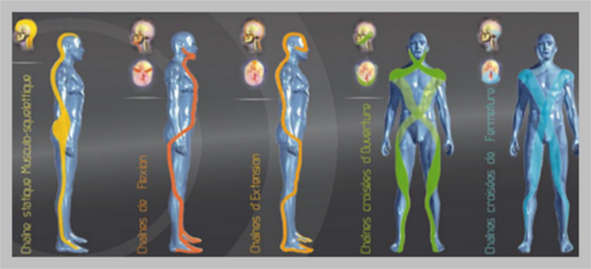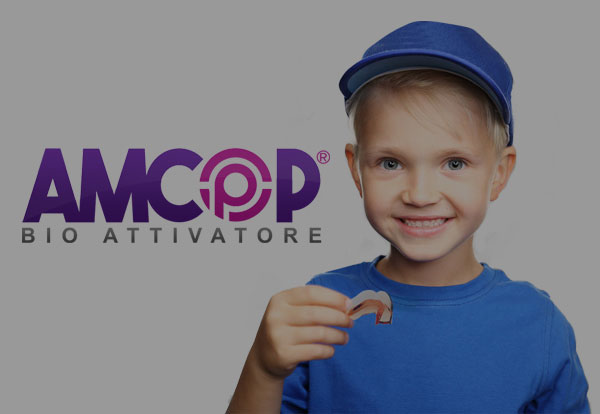The position of the mouth and head is a component of the general postural structure. Any misalignment of the head creates disharmonies and tension asymmetries in the neck muscles, which differ according to the type of deviation.
These tensions connect with others of the underlying trunk muscles and the facial and chewing muscles above. They act by deforming structures.
RELATIONSHIP BETWEEN TEETH AND MUSCLE CHAINS

Muscle chains are a set of muscles intimately connected to each other by a specific functional purpose. These chains are fundamental as they concretely realize the postural pattern elaborated at the level of the brain, similar to the threads that support the puppets. A good balance between the various muscle chains results in a good postural balance. Postural balance is the result of the balance of all muscle chains; this balance is linked to the correct functionality of all receptors.
The term "posture" indicates the position of the body with respect to space and its segments in relation to each other. When we refer to posture, we mean the position taken in an upright position as a result of the play of forces which, acting on the skeleton, make it possible to counteract gravity. From this point of view, the body can be represented as a scaffold that is supported by the balanced play of the tie rods that act on it.
In the human body the tie rods are represented by myofascial chains; therefore, not only the muscles that are inserted into the skeleton through the tendons are considered, but the complex system of muscles inserted in the fascial environment that surrounds them, penetrates them and joins them together as well as connecting them to the skeleton.
The muscle chains would manage the posture and postural imbalances would arise from their retraction. The myofascial chains are like a system in which each muscle, surrounded and interconnected with the others through the connective tissue, functions through a mechanism of reciprocal transmission of forces; in this system the connective fascia acts as a mechanical transducer that records posture and movement patterns and participates in motor coordination.
The posterior superficial chain is balanced by the frontal superficial chain and the two together manage posture in the sagittal plane. The lateral chain opposes lateral imbalances, therefore they manage posture and movements in the frontal plane.
The first-class occlusion induces a good relationship between the shoulder girdle and the pelvic girdle. Second-class occlusion involves a forward movement of the head and shoulders, inducing anteriorization of the shoulder girdle with respect to the pelvic girdle. Third-class occlusion involves a backward movement of the head and shoulders, inducing a posteriorization of the shoulder girdle with respect to the pelvic girdle.
The tensions in the sagittal plane are justified by the fascial relations of the tongue and the hyoid bone (hence the mandible) with the cervical spine, in particular C2 and C3. A mandibular dysfunction affects the structure of the cervical spine, therefore the position of the head. The positions of the neck and head are closely related to the position of the jaw and chewing.
On the frontal plane, the lateral deviation of the mandible can cause an imbalance in the alignment of the shoulders with the pelvis, causing an inclination of the shoulder, contralateral or homolateral with respect to the inclination of the pelvis.
According to Brodie's scheme, cervical-cranial-mandibular balance is fundamental for occlusal homeostasis and plays an important role in shaping the postural matrix.
The cervical tract is the most mobile part of the spine. It supports, stabilizes and makes the skull mobile, protecting the structures that pass through it. An abnormal swallowing associated with imbalances of the craniofacial structures inevitably affects the first cervical vertebrae with repercussions on posture.
It is possible to consider the deviations of the craniofacial-mandibular structures as true scoliosis of this system. occlusion is a continuous dynamic process and is the result of a cranial brain bio-dynamics.
The occlusion, therefore, will be influenced by so-called ascending pathologies in relation to cranial, but also cranial-sacral stresses.
According to some authors, posture arises in the skull and from the skull; the bones of the craniofacial system can be considered metamorphosed vertebrae and there is a structural continuity between the skull and the vertebral column.
In this perspective, the first vertebra can be considered the pre-sphenoid, the second the post-sphenoid, the third the occiput, the atlas first vertebra of the spine can be considered the fourth vertebra, which behaves like an adaptive meniscus between the spine and the skull.
This is the reason why a malocclusion can present itself as a true cranial scoliosis capable of determining various dysmetria of the craniofacial mass, with consequent alteration of the vertebral column. It is possible to detect this type of decompensation by reading the aesthetics of the face. When there is decompensation, it is possible to find a dysmetrical facepiece conditioned by different types of deformation of the skull and visus, such as deviations of the lips, nose, ears, misaligned eyes and crooked jaws. These factors must be taken into serious consideration as a reading of a dento-craniofacial system that is not working, as they signal the presence of a malocclusion.

CONCLUSIONS
The treatment with our AMCOP Bio Activators, functional orthodontic devices made of completely elastic materials and produced in Bari, is of a "purely orthopedic" nature of the craniofacial skeletal structures. We mean a much more specific type of functional orthopedics, aimed at restoring the various distortions of the dental arches, the skull and the visus. Furthermore, together with the deviations of the dental arches of the skull and of the visus, the deviations of the head on the trunk and of the posture must also be taken into consideration in full compliance with those important correlations between mouth and posture that have already been extensively written. The AMCOP Bio Activators, true functional orthopedic orthodontic devices allow to act on the different dysmorphosis of the mouth, thus reconditioning the deformations of the body and acting on the posture.


